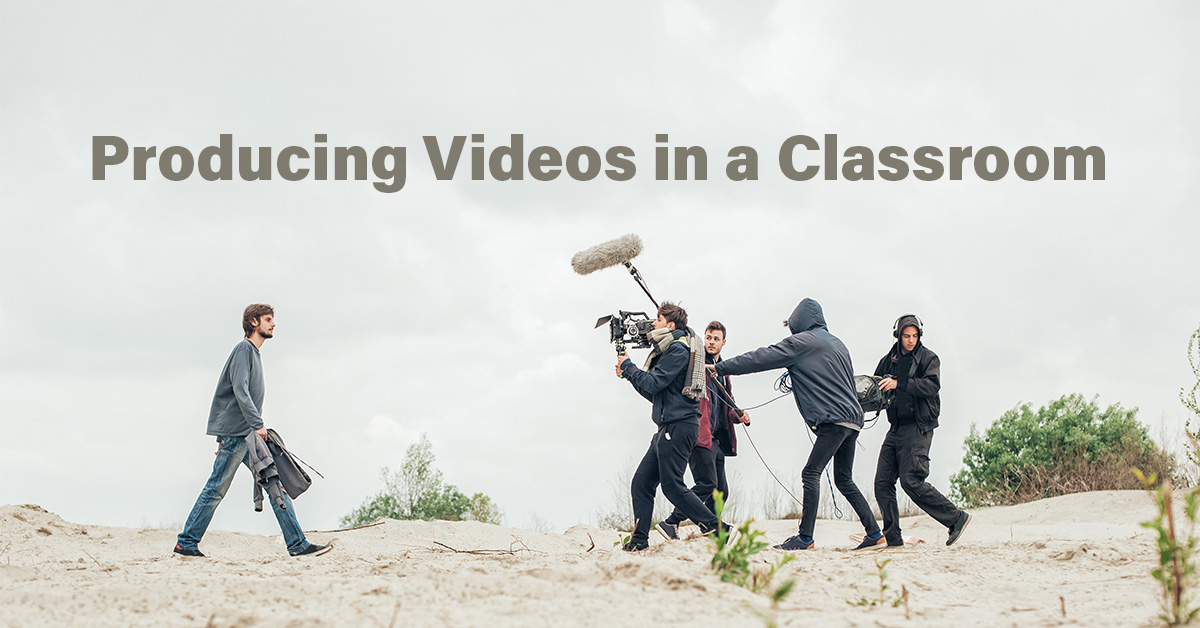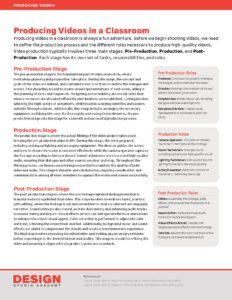Producing videos in a classroom is always a fun adventure. Before we begin shooting videos, we need to define the production process and the different roles necessary to produce high-quality videos. Video production typically involves three main stages: Pre-Production, Production, and Post-Production. Each stage has its own set of tasks, responsibilities, and roles. Once we define these stages and roles, we’ll talk about how two-person and six-person teams will be structured.
Pre-Production Stage
The pre-production stage is the foundational part of video production, where meticulous planning and preparation take place. During this stage, the concept and goals of the video are defined, and a detailed script is written to outline the dialogue and scenes. Storyboarding is used to create visual representations of each scene, aiding in the planning of shots and sequences. Budgeting and scheduling are crucial tasks that ensure resources are allocated efficiently and timelines are established. Casting involves selecting the right actors or presenters, while location scouting identifies and secures suitable filming locations. Additionally, this stage includes arranging the necessary equipment and hiring the crew. By thoroughly addressing these elements, the pre-production stage sets the stage for a smooth and successful production process.
Pre-Production Roles
- Producer: Oversees the project, manages the budget, and coordinates the team.
- Director: Develops the creative vision and directs the overall production.
- Scriptwriter: Writes the script, including dialogue and scene descriptions.
- Storyboard Artist: Creates visual representations of scenes to plan the shots.
Production Stage
The production stage is where the actual filming of the video project takes place, bringing the pre-production plans to life. During this stage, the set is prepared, including setting up lighting and arranging equipment. The director guides the actors and crew to ensure the script is executed effectively while the camera operator captures the footage according to the storyboard. Sound technicians work to record high-quality audio, ensuring that dialogue and other sounds are clear and crisp. Throughout the filming process, continuous monitoring is essential to maintain the quality of both video and audio. This stage is dynamic and collaborative, requiring coordination and communication among all team members to capture the envisioned scenes successfully.
Production Roles
- Camera Operator: This person handles the camera work and captures the footage.
- Sound Technician: Manages audio recording and ensures high-quality sound.
- Lighting Technician: Sets up and adjusts lighting to enhance the visual quality.
- Actor/Presenter: Performs in front of the camera, delivering the script.
Post-Production Stage
The post-production stage is where the raw footage captured during production is transformed into a polished final video. This stage involves several key tasks, starting with editing, where the footage is cut and assembled to create a coherent and engaging narrative. Sound editing is also crucial, as it involves mixing and enhancing audio tracks to ensure clarity and impact. Visual effects artists can add special effects or animations to enhance the video’s visual appeal. Color correction is performed to adjust the color and tone, achieving the desired look and feel. Additionally, background music and sound effects are added to complement the visuals and create a more immersive experience. The final step involves reviewing the edited video and making any necessary revisions before exporting it in the desired format and quality. This stage is crucial for refining the video and ensuring it aligns with the project’s goals and standards.
Production Roles
- Editor: Assembles the footage, adds effects, and ensures the final product is polished.
- Sound Editor: Edits and mixes audio tracks for clarity and impact.
- Visual Effects Artist: Creates and integrates visual effects into the footage.
- Colorist: Adjusts the color and tone of the footage to achieve the desired look.
2-Person Production Team
In a two-person team, there will be significant overlap between roles. These projects will be smaller and involve less planning and technical requirements. First, you need to determine who will be the director and who will be the talent in front of the video. Once you have that done, you will begin planning the shoot.
Pre-Production Roles
In this stage, both students are responsible for planning and storyboarding the video. Together, you will develop the script and storyboard for the video. You will then submit one storyboard for the proposed video.
Production Roles
When producing the video, the director will serve as both the camera operator and talent director. Audio will be captured directly by the camera, and both the talent and director will review the video on the camera to ensure it looks appropriate.
Post-Production Roles
When editing the video, both students will collaborate on the project. One final video will need to be submitted for the two-person team.
Credit Roll
Use the following template to create your credits:
- Director
- Writers
- Cast
- Camera Operator
- Video Editors
6-Person Production Team
In the six-person team, there will be more defined roles for students. These projects will be larger, with off-camera audio, lighting, and multiple cameras. First, you need to determine who will be the director, who will then help assign roles to the other team members. Remember, I expect everyone to rotate through roles on each project.
Pre-Production Roles
In this stage, ALL students are responsible for planning and storyboarding the video. Together, you will develop the script and storyboard for the video. You will then submit one storyboard for the proposed video.
Production Roles
When producing videos in a six-person team, the director is responsible for managing the talent. One student will serve as the camera operator, responsible for framing the shot and ensuring the video is captured. One student will serve as the sound technician, ensuring that good, clean audio is captured off-camera. One student will serve as the lighting technician, assisting with the lighting of each scene. The lighting technician will also help in synchronizing the audio and video using the slate. The last two students will be featured in the video.
Post-Production Roles
When editing the video, ALL students will collaborate on the project. There are different approaches to sharing the workload, and as a team, you’ll need to determine what works for you. I suggest you have one person ingest the content into Premiere Pro and order the shots and scenes. Another person could then work on syncing the video with the external audio in the shots. The following person could build a rough edit of the scene. The following person could then take feedback and create a final cut. The following person would work on the audio and background music. The final person could do the color correction and color grading. Using this approach, all six students would have a role in the process.
Credit Roll
Use the following template to create your credits:
- Director
- Writers
- Cast
- Camera Operator
- Sound Technician
- Lighting Technician
- Video Editors
References
Copilot. (2025, April 1). Order of credits at the end of a video. Retrieved from Microsoft Copilot.
Copilot. (2025, April 1). Post-Production stage of video projects. Retrieved from Microsoft Copilot.
Copilot. (2025, April 1). Pre-production stage of video production. Retrieved from Microsoft Copilot.
Copilot. (2025, April 1). Production stage of video projects. Retrieved from Microsoft Copilot.
Copilot. (2025, April 1). Roles for creating videos. Retrieved from Microsoft Copilot.
Copilot. (2025, April 1). Stages of video production. Retrieved from Microsoft Copilot.







